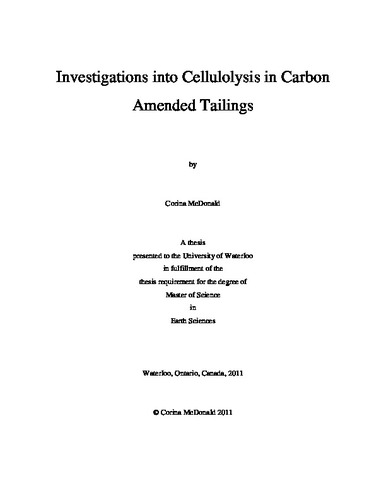| dc.description.abstract | Modified cellulase enzyme assay methods were developed to determine the potential of using enzyme activities to evaluate the decomposition of organic matter in carbon amended mine tailings systems. Cellulase assays are commonly performed in soil science applications, industrial production and bio-energy research to determine organic matter response to physical, chemical or temporal variation but, they have not been applied in a mine waste environment. Heavy metal content is considered to be a potential inhibitor to cellulase enzyme activity.
Using samples collected from Greens Creek Mine in Juneau, Alaska, USA, the modified assay was evaluated to develop a method that provided reproducible results. It was determined that a sample mass of three grams is sufficient to provide consistent enzyme measurements. Each sample location was characterized by four replicates to ensure statistically representative data. Matrix interferences were determined to be inconsequential in this system. Despite the low organic content amended to the tailings, heavy metal content and potentially low enzyme activity, the modified enzyme assay method provided reproducible enzyme measurements.
Following the development of the cellulase assays, spatial and temporal variations in cellulase enzymes were investigated from carbon amended tailings samples collected at the Greens Creek Mine. Six test cells, containing a mixture of tailings and a combination of peat, spent brewery grain and/or municipal biosolids were sampled in the fall of 2005, 2007 and 2009. Exo-(1,4)-β-D-glucanase (EC 3.2.1.91), Endo-(1,4)-β-D-glucanase (EC 3.2.1.4) and β-glucosidase (EC 3.2.1.21) enzymes were assayed from core sections at five different depths. Enzyme activities were compared to sulfate reducing and acid producing bacterial enumerations, sulfide trends and carbon content. General trends were consistent between enzyme activity and SRB enumerations. The range of total carbon values fell between 3 and 5 wt % in each test cell while the average inorganic carbon content was 3.5 wt %. The range of organic carbon content was between 0.2 and 1.2 wt %. Total, inorganic and organic carbon values were more characteristic of test cell carbon distribution.
Cellulase enzyme assays provide valuable information regarding the degradation of cellulose and hemi-cellulose. This study demonstrates that enzymes can be monitored in a tailings environment and that enzyme assays conducted for monitoring purposes may be a useful practice to indicate the sustained or declining performance of organic matter in a carbon amended remedial system. | en |

